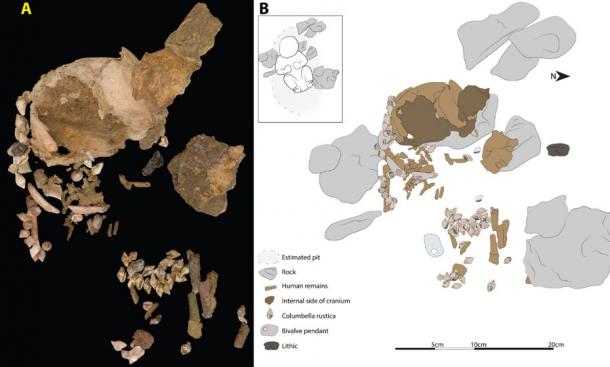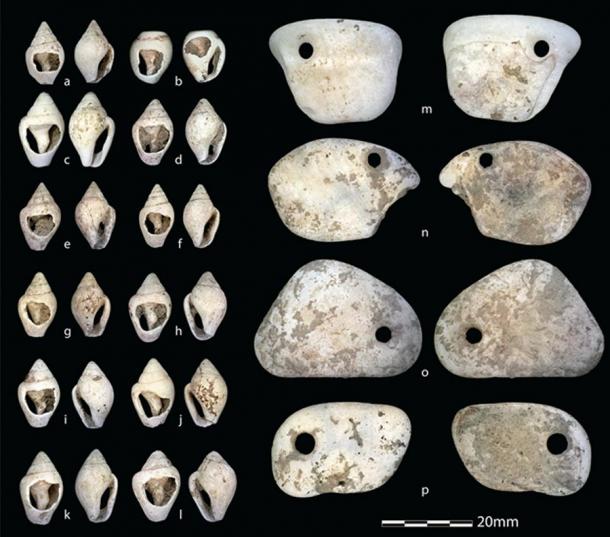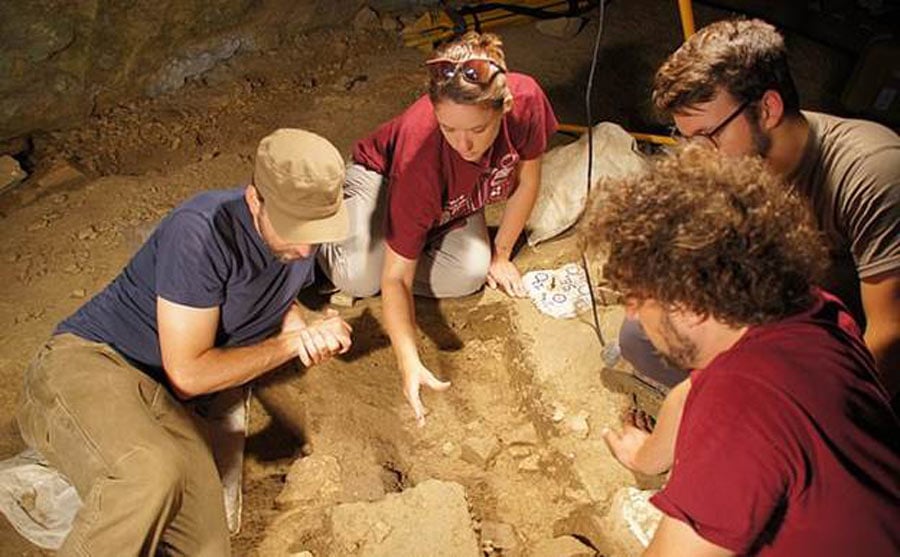10,000-Year-Old Mesolithic Burial Showed Special Reverence For Infant Girl
Archaeologists and paleoanthropologists exploring a cave in Italy excavated parts of a skeleton that belonged to an infant girl who died approximately 10,000 years ago, in the early Mesolithic period shortly after the end of the last Ice Age. The sparse remains of the girl’s tiny body were surrounded by more than 60 pierced shell beads, four shell pendants, and an eagle-owl talon that likely had some type of symbolic meaning.
The body of the infant, who the scientists have nicknamed “Neve,” was originally discovered in the Arma Veirana cave in 2017. After the careful excavation of the skeletal remains and associated artifacts they were studied in detail. The results obtained from the study of the skeleton and the objects recovered from the burial have only now been disclosed to the scientific community, in a new article published in Scientific Reports.

The Mesolithic girl infant’s burial layout. (A) Progressive 3D photogrammetric image of each piece prior to removal, reconstructing the bones and artifacts as they were in situ. (B) Inset tracing demonstrating the likely body position. (Scientific Reports)
Mesolithic Girl Infant’s Remains: A Rare and Important Find
It is extremely rare to find burials traceable to the early Mesolithic period. That makes this an incredibly important find. “The evolution and development of how early humans buried their dead as revealed in the archaeological record has enormous cultural significance,” the researchers wrote.
While burials like Neve’s are uncommon, there are similarities between her preparation and that of two infants found during an excavation of an ancient burial site near Upward Sun River in Alaska in 2013. Those children lived and died about 1,500 years before Neve, however, which suggests two possible explanations for the similarity in traditions.
- 10,000+ Artifacts, Including Mesolithic Tools, Found in Russia
- Mesolithic sanctuary reveals evidence of ritual and astronomical practice
One is that the ancient North American and Southern European cultures inherited their burial customs for female infants from an older ancestor culture they both shared. The second possibility is that each society’s customs evolved separately, and only seem closely connected because of a common cultural outlook.

Shell ornaments found near the Mesolithic girl infant’s remains. Examples of Columbella rustica shell beads (a–l), and pierced pendants made from Glycmeris sp. (m–p). (Scientific Reports)
Unearthing the Truth about Neve and the Story of Her People
Arma Veirana cave in northwestern Italy was targeted by looters in 2015, and it was their illicit digging that first revealed the presence of tools left behind by late Ice Age inhabitants.
Between 2015 and 2017, an international team of experts, led by paleoanthropologists Jamie Hodgkins and Caley Orr from the University of Colorado-Denver, spent most of their time excavating 50,000-year-old tools and artifacts from the vicinity of the cave’s mouth. These were identified as Mousterian tools, meaning they were left behind by Neanderthals.
While these discoveries were exciting, the archaeologists and paleoanthropologists were equally intrigued by a set of younger tools found deeper in the cave’s interior. Further excavations at these locations ultimately led to the discovery of the skullcap and teeth of the infant girl, along with the ornaments buried alongside her.
A closer examination of these items revealed that each had been made carefully and with precision. The pierced beads, pendants, and eagle-owl talon showed quite a bit of wear, which suggested they were family heirlooms that had been passed down to the child by her parents or by other close relatives.
From studying Neve’s teeth, the researchers concluded that she’d been less than two months old when she’d passed away. Radiocarbon dating confirmed that she had lived around 8,000 BC, while the study of proteins and a DNA sample retrieved from her skeleton revealed her gender.
“There's a decent record of human burials before around 14,000 years ago,” Jamie Hodgkins explained in an Arizona State University press release about her team’s findings (Hodgkins and study co-author Caley Orr received their doctoral degrees from this university). “But the latest Upper Paleolithic period and earliest part of the Mesolithic are more poorly known when it comes to funerary practices. Infant burials are especially rare, so Neve adds important information to help fill this gap.”
“The Mesolithic is particularly interesting,” Orr added. “It followed the end of the final Ice Age and represents the last period in Europe when hunting and gathering was the primary way of making a living. So, it’s a really important time period for understanding human prehistory.”

An artist's depiction of life in the Mesolithic era or Middle Stone Age in Europe. (Marcos Oliveira / Children in History)
Correcting the Archaeological Record
Archaeologists and paleoanthropologists agree that funerary practices offer important insights into ancient social structures and cultures, which for pre-historical groups are otherwise difficult to analyze.
The post-death treatment of children reveals the truth about how valued the younger members of hunter-gatherer tribes actually were. There would be no reason to automatically assume they would be valued, given the fact they wouldn’t have been able to contribute much to the group’s survival.
It is clear from the artifacts recovered from Neve’s tomb that her people loved and cherished the youngest group members, female as well as male. The great care and effort her parents and her society took to ensure Neve’s smooth entrance into the next world proves they viewed her as a spiritual being and experienced her loss as a trauma.
“Right now, we have the oldest identified female infant burial in Europe,” Hodgkins noted. She spoke of how important this discovery was, given archaeology’s traditional orientation when evaluating pre-historic peoples.
“Archaeological reports have tended to focus on male stories and roles,” she said, “and in doing so have left many people out of the narrative.”
Thankfully, modern innovations in ancient DNA study are helping to correct distortions in the archaeological record.
- Mesolithic Woman Stuns Onlookers With Her Electric Gaze
- 11,000-year-old Spiritualized Deer Masks Whisper Tales Of A Forgotten World
“Protein and DNA analyses are allowing us to better understand the diversity of human personhood and status in the past,” Hodgkins continued. “Without DNA analysis, this highly decorated infant burial could possibly have been assumed male.”
As a practicing paleoanthropologist, Hodgkins welcomes the opportunity to abandon the “singular lens” that has tended to overemphasize the role of males in creating and maintaining ancient societies.
“We need as diverse a perspective as possible, because humans are complex,” she concluded.
Unfortunately, the infant buried at Arma Veirana 10,000 years ago didn’t live long enough to help her people survive or influence their evolution. But her tragic early demise was still experienced as a loss and acknowledged as such.
Top image: It was here in the Arma Vierana cave in northern Italy where the Mesolithic infant and her shell beads were found by the research team. Source: Jamie Hodgkins / University of Colorado Denver
By Nathan Falde




















Comments
Great article from trained academics. Unlike the mad ramblings from Wagner.
More of this please.
Crasslee
The Native Americans as well as the PIE group seem to have a reverence for Eagels and other carrion birds.This is not likely a coincidence espeically considering where the modern belief of where the PIE culture began. Considering that Horses, a Native species to North America, were “first domesticated” in the Russian steppe by our PIE ancestors before going into Europe etc. it is almost certainly a connection between the two groups.
What a great find. The more we learn about our ancestors, the more they appear to be the brilliant, loving and reverent people we thought they were.